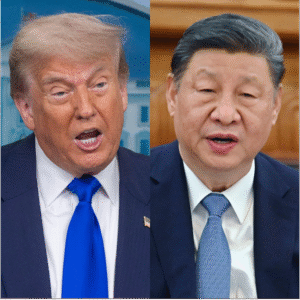16-year-old Samantha De Mesa delves into the impact of Trump’s tariffs on ASEAN countries

US president Donald Trump (left) and Chinese president Xi Jinping.
Picture by: Mehmet Eser | ZUMA Press, Inc. | Alamy Johannes Neudecker | dpa | Alamy
Article link copied.
July 11, 2025
The impact of the US-China trade war on Southeast Asia

Amid the escalating trade war between the United States and China, one key question emerges: does this global trade war bring new opportunities for Southeast Asian countries, or create more challenges?
On 9 April, US president Donald Trump raised the baseline tariff on most Chinese imports to 145%. Not to be undone, President Xi Jinping of China struck back with retaliatory tariffs to a minimum of 125%. Since then, the eagle and dragon have been locked in a fierce tit-for-tat battle, with the standoff appearing to have eased on 10 June when US tariffs on Chinese imports dropped to 55%, while Chinese tariffs on US goods dropped to 10%.
Trump also imposed tariffs on various Southeast Asian countries on the same day in April, including 10% on Singapore and 17% on the Philippines to a very steep 46% on Vietnam and 49% on Cambodia.
Harbingers’ Weekly Brief
This is potentially disastrous for ASEAN countries, which rely heavily on exports, particularly with the United States. For example, Cambodia’s exports to the US in 2024 were nearly 38% of total shipments. ASEAN (full name: Association of Southeast Asian Countries) is a regional group that works to promote economic and security cooperation among its ten member countries.
According to the International Monetary Fund (IMF), the projected growth rate for ASEAN countries will reduce to 3.9% from the forecasted 4.6% last year, demonstrating the economic impact of American tariffs in the region.
Tricia Yeoh, associate professor of practice at the University of Nottingham Malaysia, believes “the increasingly inconsistent and erratic policymaking from the Trump administration will ultimately push Southeast Asia away from making deals with the US, an increasingly unreliable trade partner.”
In response to Trump’s tariffs, President Xi Jinping visited Vietnam, Malaysia and Cambodia in mid April to strengthen China’s ties with its partners in the region.
The US and China, long engaged in a struggle for dominance as the world’s two largest economies, seem increasingly unlikely to reach a compromise, especially following unpredictable policy shifts on both sides.
Nonetheless, the ongoing trade war pressures ASEAN countries to choose sides, putting them in an uncomfortable position.
As the United States and Europe scaled back economic ties with China, Beijing shifted its focus to expanding exports across the Global South, notably in Southeast Asia. In 2024, the percentage of China’s exports that went to ASEAN countries stood at 16.4%, compared with 14.7% to the US and 14.4% to Europe.
Much of those exports were then re-routed to the US and Europe, a process known as transshipment.
In early May, AMRO – China, Hong Kong, Japan and South Korea, along with the ten ASEAN states – issued a statement on economic challenges and global trade. The countries criticised “escalating trade perfectionism”, warning that it caused “economic fragmentation, affecting trade, investment, and capital flows across the region.”
They also said they were committed to ensuring that “financial systems and markets remain resilient despite the uncertainty, while maintaining open communication among members in light of the rapidly evolving developments,” showing their readiness to coordinate regional strategies to combat the United States.
While a compromise between China and the US was initially considered close to “impossible”, US treasury secretary Scott Bessent touted “substantial progress” after a meeting in Genevabetween the two countries in mid May.
A 90-day reprieve on retaliatory tariffs began on 14 May, wherein the US reduced the tariffs on imports from China to 30% from the original 145%. The 125% tariffs on US imports was also reduced to 10%. However, Trump’s 20% fentanyl-related tariffs on China remain.
On 30 May, Trump posted on Truth Social, accusingChina of retracting on the deal made in Geneva. “The bad news is that China, perhaps not surprisingly to some, HAS TOTALLY VIOLATED ITS AGREEMENT WITH US,” Trump wrote. In response, China urged the US “cease discriminatory restrictions against China and jointly uphold the consensus reached at the high-level talks in Geneva”.
This clash was preceded by the ruling of the US Court of International Trade in New York, which stated that Trump had no authority to impose sweeping tariffs, including those on China. The Trump administration has appealed the decision.
On 27 June, US treasury secretary Scott Bessent said that Washington could wrap up trade deals by early September. China confirmed that they would continue to “review and approve” items under export controls.
While there is hope of a potential compromise for both countries, the US–China trade war continues to rumble on, sending shockwaves across global markets. One thing remains clear: ASEAN nations are playing a high-stakes gamble, caught between the world’s largest economies. They can choose whether to throw their weight behind a potential victor or hedge their bets by courting both powers.
As supply chains shift, investment patterns change and regional influence is at stake, the choice ASEAN makes today could shape its economic and geopolitical trajectory for decades to come.
Written by:

The Harbinger Prize 2024 (International Affairs)
Writer
Cavite, Philippines
Born in 2009 in Cavite, Philippines, Samantha now studies in Manila. She is interested in literary and performance arts and plans to study medical anthropology. She joined the magazine having won the International Affairs category of the Harbinger Prize 2024.
After successfully completing the Essential Journalism course, Samantha became a writer for Harbingers’ Magazine starting in March 2025.
In her free time, Samantha enjoys writing proses and poetries. She won Notable Submission Award in 2021 Bow Seat Ocean Awareness Contest Poetry & Spoken Word Junior Category and is one of the runner-ups in the 2022 Immerse Education Essay Competition.
Samantha speaks Filipino and English.
Edited by:

🌍 Join the World's Youngest Newsroom—Create a Free Account
Sign up to save your favourite articles, get personalised recommendations, and stay informed about stories that Gen Z worldwide actually care about. Plus, subscribe to our newsletter for the latest stories delivered straight to your inbox. 📲
© 2025 The Oxford School for the Future of Journalism


